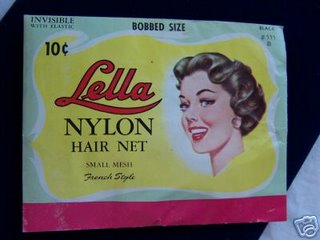Sunday, April 30, 2006
Beauty Buzz: Too Many Choices in the Shampoo Aisle?
We've Moved!! Check out the all new Beauty Brains.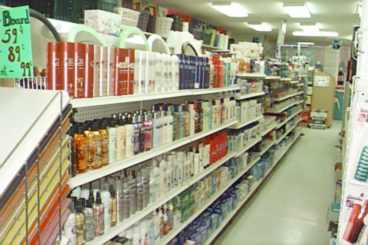
We came across an interesting shampoo rant by UK blogger by Rob Fisher that touches on some of the same themes that we write about here. You can check out the entire article, but here are a few pithy quotes from Rob followed by The Brains comments:
Rob Writes:
“I find shopping for toiletries an overwhelmingly draining experience. I can stare at an entire aisle of shampoo for hours, just looking your basic, ordinary, not-too-cheap, not-too-expensive, not-containing-any-wierd-ingredients shampoo. It’s nearly impossible. There’s too much choice!”
The Brains Comment:
What do you people in the real world think? Are there too many choices out there for shampoo and other personal care products?
Rob Writes:
“Yet could it be that all this choice is a good thing? After all, whether you have blonde, coloured, curly, damaged, dry, fine, frizzy, greasy, lifeless, oily, permed, thin, tired, treated, unmanageable or wavy hair, you need to make sure you have the right shampoo for you. And you will be provided for, even if you have greasy roots but dry tips. Pity the poor soul who has “normal” hair, but even amongst this vast array of hair categories there is room for normal hair shampoo. (It seems to me that the marketeers have admitted defeat with normal shampoo.)”
The Brains Comment:
He’s got an interesting point here, modern shampoos stay away from the term “normal” hair and instead chose names that communicate benefits, ala “Sleek and Smooth.”
Rob Writes:
“You can get shampoo that clarifies, energises, fortifies, hydrates, nourishes (from root to tip), nurtures, protects, refreshes, repairs, revitalises, strengthens, tames and volumises your hair.
You can choose from shampoo that boosts vitality; builds inner strength; dramatically increases body and fullness; enhances softness; enriches the vital substance; frees the scalp and hair of impurities in a wave of freshness; frees your mind and spirit (proving that there’s more to shampoo than just hair); improves manageability (by up to 87% - although how it is possible to measure something like “manageability” so accurately is beyond me); increases moisture retention (by up to 49%); infuses moisture; locks in colour and shine; neutralises dulling minerals in water; promotes healthy hair and scalp, a radiant shine, or silkiness and lustre; protects hair from drying out; reduces breakage from brushing; reduces frizz or dandruff; removes itchiness and irritation; restores the scalp’s natural balance smooths all the way to the tip; tames annoying flyaways; targets areas of weakness; wakes you up; or works inside of the hair fibre. Few would argue that these options aren’t vital for the functioning of society.”
The Brains Comment:
Wow, is this guy cynical or what? But, we do agree with some of his points. Consumers have no way of evaluating many of the benefits that shampoo marketers present to you. How would you know what an emollient is doing to your hair, or how can you tell when your hair is 5x stronger? The truth is, you can’t!
Now, that doesn’t mean the beauty companies are deliberately misleading you. It doesn’t mean they’re selling crappy products. It just means that’s the way this marketplace works: to stay in business, companies have to constantly reinvent their products and claims. The reputable companies can prove everything they say about their products, but that proof may be based on esoteric scientific tests that don’t directly relate to anything you could perceive when you use the product.
Is that bad? Not necessarily. If their advertising says something that gets you to buy the product and you like it, then both you and the company win. If on the other hand, you try the product and you don’t like it, if you feel they “tricked” you into buying something that doesn’t work, well then, you won’t buy the product again and the company loses.
So, as long as the beauty industry keeps selling quality products and as long as they promote those products with claims based on scientific testing, there’s nothing wrong with them trying to catch your attention with creative language.
Finally, Rob Writes:
“Then there are plenty of magazines that will happily inform stupid, gullible people, through a series of annual awards, what the best shampoos are and why they need their hair protected from the dulling minerals in water, and these are in no way in collusion with the overpaid arts graduates who lied their way into marketing jobs at shampoo companies. So don’t whine over your dry, damaged hair; adopt the Aussie philosophy: “There’s more to life than hair, but it’s a good place to start.”
The Brains Comment:
Ouch. We don’t like the beauty product consuming public being described as “stupid” and gullible. But, having worked in the industry for many years, there’s something about the line “overpaid arts graduates who lied their way into marketing jobs at shampoo companies” that just makes us smile.
But seriously, buying beauty products is really no different than shopping for a car or making any other complicated purchase: you should begin to educate yourself before you start buying. And that’s why The Beauty Brains are here - to, as Aussie says, give you a “good place to start.”

We came across an interesting shampoo rant by UK blogger by Rob Fisher that touches on some of the same themes that we write about here. You can check out the entire article, but here are a few pithy quotes from Rob followed by The Brains comments:
Rob Writes:
“I find shopping for toiletries an overwhelmingly draining experience. I can stare at an entire aisle of shampoo for hours, just looking your basic, ordinary, not-too-cheap, not-too-expensive, not-containing-any-wierd-ingredients shampoo. It’s nearly impossible. There’s too much choice!”
The Brains Comment:
What do you people in the real world think? Are there too many choices out there for shampoo and other personal care products?
Rob Writes:
“Yet could it be that all this choice is a good thing? After all, whether you have blonde, coloured, curly, damaged, dry, fine, frizzy, greasy, lifeless, oily, permed, thin, tired, treated, unmanageable or wavy hair, you need to make sure you have the right shampoo for you. And you will be provided for, even if you have greasy roots but dry tips. Pity the poor soul who has “normal” hair, but even amongst this vast array of hair categories there is room for normal hair shampoo. (It seems to me that the marketeers have admitted defeat with normal shampoo.)”
The Brains Comment:
He’s got an interesting point here, modern shampoos stay away from the term “normal” hair and instead chose names that communicate benefits, ala “Sleek and Smooth.”
Rob Writes:
“You can get shampoo that clarifies, energises, fortifies, hydrates, nourishes (from root to tip), nurtures, protects, refreshes, repairs, revitalises, strengthens, tames and volumises your hair.
You can choose from shampoo that boosts vitality; builds inner strength; dramatically increases body and fullness; enhances softness; enriches the vital substance; frees the scalp and hair of impurities in a wave of freshness; frees your mind and spirit (proving that there’s more to shampoo than just hair); improves manageability (by up to 87% - although how it is possible to measure something like “manageability” so accurately is beyond me); increases moisture retention (by up to 49%); infuses moisture; locks in colour and shine; neutralises dulling minerals in water; promotes healthy hair and scalp, a radiant shine, or silkiness and lustre; protects hair from drying out; reduces breakage from brushing; reduces frizz or dandruff; removes itchiness and irritation; restores the scalp’s natural balance smooths all the way to the tip; tames annoying flyaways; targets areas of weakness; wakes you up; or works inside of the hair fibre. Few would argue that these options aren’t vital for the functioning of society.”
The Brains Comment:
Wow, is this guy cynical or what? But, we do agree with some of his points. Consumers have no way of evaluating many of the benefits that shampoo marketers present to you. How would you know what an emollient is doing to your hair, or how can you tell when your hair is 5x stronger? The truth is, you can’t!
Now, that doesn’t mean the beauty companies are deliberately misleading you. It doesn’t mean they’re selling crappy products. It just means that’s the way this marketplace works: to stay in business, companies have to constantly reinvent their products and claims. The reputable companies can prove everything they say about their products, but that proof may be based on esoteric scientific tests that don’t directly relate to anything you could perceive when you use the product.
Is that bad? Not necessarily. If their advertising says something that gets you to buy the product and you like it, then both you and the company win. If on the other hand, you try the product and you don’t like it, if you feel they “tricked” you into buying something that doesn’t work, well then, you won’t buy the product again and the company loses.
So, as long as the beauty industry keeps selling quality products and as long as they promote those products with claims based on scientific testing, there’s nothing wrong with them trying to catch your attention with creative language.
Finally, Rob Writes:
“Then there are plenty of magazines that will happily inform stupid, gullible people, through a series of annual awards, what the best shampoos are and why they need their hair protected from the dulling minerals in water, and these are in no way in collusion with the overpaid arts graduates who lied their way into marketing jobs at shampoo companies. So don’t whine over your dry, damaged hair; adopt the Aussie philosophy: “There’s more to life than hair, but it’s a good place to start.”
The Brains Comment:
Ouch. We don’t like the beauty product consuming public being described as “stupid” and gullible. But, having worked in the industry for many years, there’s something about the line “overpaid arts graduates who lied their way into marketing jobs at shampoo companies” that just makes us smile.
But seriously, buying beauty products is really no different than shopping for a car or making any other complicated purchase: you should begin to educate yourself before you start buying. And that’s why The Beauty Brains are here - to, as Aussie says, give you a “good place to start.”
Saturday, April 29, 2006
Beauty Q & A - Skin Toners and Astringents
We've Moved!!! Check out our new site at The Beauty Brains.
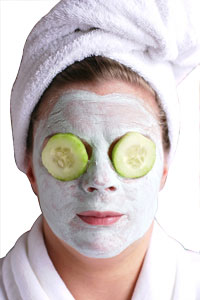
A Question from the Glamorous Glitterati Goes Like This:
My facialist told me that toners are important because they re-balance the pH of the skin after cleansing. I could see that cleansers might be slightly basic, but will the toner really re-balance that?
I like toners anyway for the astringent properties you mention, so I'd continue using them regardless of the pH factor. Oh, and the facialist used a toner from Dermalogica. Would there be a "pH difference" between the pricey stuff and the drugstore brands?
The Right Brain Rapidly Responds:
You have a facialist? I’m lucky if I can get someone to cut my hair! But that’s enough commentary on our personal grooming practices; let’s get right to your questions…
Will a toner really rebalance your skin pH? Well, a skin toner is kind of like your appendix – you have one but your body doesn’t really need to use it. Your skin pH is a result of the skin’s acid mantle, a mixture of sebum (skin oils) and sweat that form on the surface of your skin. This acid mantle keeps the pH of your skin at about 4 to 4.5 (Remember, low pH like 1 to 5 is acidic, high pH 8 or above is basic, and the middle, around 7, is neutral. Anyway, this slightly acidic pH is a good thing on your skin because it helps ward off harmful bacteria.
When you wash your skin, you strip away this acid mantle. That’s because the detergents in cleansers are very good at dissolving oils. But don’t worry, because over the next few hours, your skin will regenerate the mantle by itself.
So what about the toner? What does it do? Not much apparently.
Check out what Smartskincare.com has to say on the subject:
"Toning is often touted as an essential step in a skin care routine. It is not. At least not always. The only exception is very oily skin. If you have oily skin and after cleansing it remains sticky or oily, you might benefit from applying toner after cleansing. Otherwise toning may do more harm than good.
Most toners contain alcohol and/or witch hazel. Both are drying and irritating, especially if you have dry or sensitive skin. If you still feel you need a toner, use a soothing toner free of alcohol or witch hazel, such as alcohol-free toner with chamomile.
You do not want to strip every last molecule of oil from your skin. Only grime, makeup and excess oil on the surface needs to be removed. The underlying thin coat of fresh sebum is best left undisturbed. Toners, especially alcohol-based ones, tend to strip everything off, leaving the skin dry and/or irritated.
Some experts argue that toners help close pores and tighten cell gaps after cleansing, thus reducing the penetration of impurities and environmental contaminants into the skin. Whether this is true is debatable. Even assuming it is, most people finish their skin care routine by applying skin care products with active ingredients, in which case you actually want as much penetration as possible. Preceding an active treatment with a toner that closes pores and tightens cell gaps may be counterproductive. After the active product has absorbed into your skin, you can close pores simply by cooling your face. The cold constricts blood vessels and closes pores, producing a toning effect. You can simply step outside if it is a cold time of the year or gently pat your skin with a cold pack (refrigerated but not frozen) for a few seconds. If you are not using any active products, you can tone after cleansing by wiping your face with a chip of frozen green tea. The cold from the ice helps close your pores; the caffeine and tannins in the tea help tighten skin and reduce puffiness; and green tea polyphenols may provide antioxidant benefits. But don't overuse the cold - frequent excessive cooling may increase the risk of developing rosacea (stubborn skin redness)."
Interesting, huh?
You also asked about a pH difference between pricey brands and drugstore brands. Here’s the scoop on that: First of all, the price of the product has no bearing on how the “quality” of the pH. There are pH balanced products at all price points. But secondly, and most importantly, pH of the product doesn’t matter all that much. Since your skin regenerates its natural acid mantle after you cleanse, the pH of the product you apply has very little effect. But don’t take our word for it. Check out what Argonne National Laboratory’s “Ask A Scientist” program had to say when asked about the effect of putting different pH solutions on skin:
Question:
What effect, if any, would my residential well water that has a ph of 5.5 have on my skin?
Answer:
It would have no more effect than tomato juice (fairly acidic at about pH
4) or black coffee ( about pH 5) or urine (about pH 5 to 7). Unpolluted rain has pH of about 6.2.
(If the folks over at Neutrogena are reading this, feel free to use this idea for a new line of skin toners: “Now with Tomato Juice, Urine, and Coffee! Coming soon to a drug store near you!”)
The Brain’s Bottom Line: unless you have very oily skin that needs to be degreased, don’t worry too much about using a pH balanced toner.
This Post has moved. Check out this post on the new site.

A Question from the Glamorous Glitterati Goes Like This:
My facialist told me that toners are important because they re-balance the pH of the skin after cleansing. I could see that cleansers might be slightly basic, but will the toner really re-balance that?
I like toners anyway for the astringent properties you mention, so I'd continue using them regardless of the pH factor. Oh, and the facialist used a toner from Dermalogica. Would there be a "pH difference" between the pricey stuff and the drugstore brands?
The Right Brain Rapidly Responds:
You have a facialist? I’m lucky if I can get someone to cut my hair! But that’s enough commentary on our personal grooming practices; let’s get right to your questions…
Will a toner really rebalance your skin pH? Well, a skin toner is kind of like your appendix – you have one but your body doesn’t really need to use it. Your skin pH is a result of the skin’s acid mantle, a mixture of sebum (skin oils) and sweat that form on the surface of your skin. This acid mantle keeps the pH of your skin at about 4 to 4.5 (Remember, low pH like 1 to 5 is acidic, high pH 8 or above is basic, and the middle, around 7, is neutral. Anyway, this slightly acidic pH is a good thing on your skin because it helps ward off harmful bacteria.
When you wash your skin, you strip away this acid mantle. That’s because the detergents in cleansers are very good at dissolving oils. But don’t worry, because over the next few hours, your skin will regenerate the mantle by itself.
So what about the toner? What does it do? Not much apparently.
Check out what Smartskincare.com has to say on the subject:
"Toning is often touted as an essential step in a skin care routine. It is not. At least not always. The only exception is very oily skin. If you have oily skin and after cleansing it remains sticky or oily, you might benefit from applying toner after cleansing. Otherwise toning may do more harm than good.
Most toners contain alcohol and/or witch hazel. Both are drying and irritating, especially if you have dry or sensitive skin. If you still feel you need a toner, use a soothing toner free of alcohol or witch hazel, such as alcohol-free toner with chamomile.
You do not want to strip every last molecule of oil from your skin. Only grime, makeup and excess oil on the surface needs to be removed. The underlying thin coat of fresh sebum is best left undisturbed. Toners, especially alcohol-based ones, tend to strip everything off, leaving the skin dry and/or irritated.
Some experts argue that toners help close pores and tighten cell gaps after cleansing, thus reducing the penetration of impurities and environmental contaminants into the skin. Whether this is true is debatable. Even assuming it is, most people finish their skin care routine by applying skin care products with active ingredients, in which case you actually want as much penetration as possible. Preceding an active treatment with a toner that closes pores and tightens cell gaps may be counterproductive. After the active product has absorbed into your skin, you can close pores simply by cooling your face. The cold constricts blood vessels and closes pores, producing a toning effect. You can simply step outside if it is a cold time of the year or gently pat your skin with a cold pack (refrigerated but not frozen) for a few seconds. If you are not using any active products, you can tone after cleansing by wiping your face with a chip of frozen green tea. The cold from the ice helps close your pores; the caffeine and tannins in the tea help tighten skin and reduce puffiness; and green tea polyphenols may provide antioxidant benefits. But don't overuse the cold - frequent excessive cooling may increase the risk of developing rosacea (stubborn skin redness)."
Interesting, huh?
You also asked about a pH difference between pricey brands and drugstore brands. Here’s the scoop on that: First of all, the price of the product has no bearing on how the “quality” of the pH. There are pH balanced products at all price points. But secondly, and most importantly, pH of the product doesn’t matter all that much. Since your skin regenerates its natural acid mantle after you cleanse, the pH of the product you apply has very little effect. But don’t take our word for it. Check out what Argonne National Laboratory’s “Ask A Scientist” program had to say when asked about the effect of putting different pH solutions on skin:
Question:
What effect, if any, would my residential well water that has a ph of 5.5 have on my skin?
Answer:
It would have no more effect than tomato juice (fairly acidic at about pH
4) or black coffee ( about pH 5) or urine (about pH 5 to 7). Unpolluted rain has pH of about 6.2.
(If the folks over at Neutrogena are reading this, feel free to use this idea for a new line of skin toners: “Now with Tomato Juice, Urine, and Coffee! Coming soon to a drug store near you!”)
The Brain’s Bottom Line: unless you have very oily skin that needs to be degreased, don’t worry too much about using a pH balanced toner.
This Post has moved. Check out this post on the new site.
Friday, April 28, 2006
Beauty Bits – Stem cells better than silicone?
We've Moved!!! Click here to find the all-new Beauty Brains
 You’ve probably heard about the problems with saline or silicone implants (rupturing, leaking, interfering with mammograms). And then there is the issue of them not looking natural. Well, researchers at the University of Illinois at Chicago have been investigating the problem and have reportedly come up with a solution. Dr. Jeremy Mao and his team of researchers have discovered that they can create superior implants by using cells from a patient’s own body.
You’ve probably heard about the problems with saline or silicone implants (rupturing, leaking, interfering with mammograms). And then there is the issue of them not looking natural. Well, researchers at the University of Illinois at Chicago have been investigating the problem and have reportedly come up with a solution. Dr. Jeremy Mao and his team of researchers have discovered that they can create superior implants by using cells from a patient’s own body.
The way it works is they remove a few bone marrow stem cells from your body. Then they grow these cells in a bio-scaffolding (which is just a fancy Petri dish). The scaffolding can be molded to any size or shape and over time the cells multiply and grow to that shape. When the implant is ready (after a few weeks) it is put in the body and will work just like natural breast tissue.
Of course the research is in its early stages and more long term studies will have to be completed. But the researchers are close. Someday, really natural new breasts made from your own cells will be a reality.
 You’ve probably heard about the problems with saline or silicone implants (rupturing, leaking, interfering with mammograms). And then there is the issue of them not looking natural. Well, researchers at the University of Illinois at Chicago have been investigating the problem and have reportedly come up with a solution. Dr. Jeremy Mao and his team of researchers have discovered that they can create superior implants by using cells from a patient’s own body.
You’ve probably heard about the problems with saline or silicone implants (rupturing, leaking, interfering with mammograms). And then there is the issue of them not looking natural. Well, researchers at the University of Illinois at Chicago have been investigating the problem and have reportedly come up with a solution. Dr. Jeremy Mao and his team of researchers have discovered that they can create superior implants by using cells from a patient’s own body.The way it works is they remove a few bone marrow stem cells from your body. Then they grow these cells in a bio-scaffolding (which is just a fancy Petri dish). The scaffolding can be molded to any size or shape and over time the cells multiply and grow to that shape. When the implant is ready (after a few weeks) it is put in the body and will work just like natural breast tissue.
Of course the research is in its early stages and more long term studies will have to be completed. But the researchers are close. Someday, really natural new breasts made from your own cells will be a reality.
Beauty in a Bottle: How Do Shampoos Work? Part 2: Mixing

In "How Do Shampoos Work? " Part 1, we talked about the ingredients used in shampoos and their functions. Here in Part 2, we'll deal with the question - how are those ingredients mixed together to create a shampoo?
The process actually begins in the laboratory where cosmetic formulators blend small amounts of chemicals to understand how they behave when they're mixed together. Once the chemists have a formula and they're satisfied with their ability to make a few pounds of shampoo in the lab, they then translate these mixing instructions into a version suitable for making several thousand pounds in the manufacturing plant. This process of is "scaling up."
In the manufacturing plant, shampoo is typically made in big stainless steel tanks, as large as 3000 gallons. (That's over 20,000 bottles of shampoo!). These tanks have an outer shell that can be filled with either hot or cold water - that's how the batch is heated or cooled. The tanks also have mixing blades that turn the tank into kind of a giant blender.
Ok, now we've got a formula, instructions on how to manufacture it, and a giant blender. Let's make some shampoo!

The first step is to fill the tank with some portion of the water, which is the solvent for the system - it dilutes the the rest of the ingredients to the proper concentration. A special type of water , known as deionized water , is used to ensure the product is as pure as possible. Depending on what else is in the formula, the water may be heated to make the other ingredients dissolve faster.
After the water , the other ingredients are added in a specific order. The surfactants are usually added early in the process. These ingredients range in consistency from being water thin to very jelly like. These may be dumped into the tank from drums or pumped in from other chemical storage tanks. Care must be taken when adding surfactants because they may cause excessive foam. (Remember these ingredients are detergents.) The surfactants may require heating and mixing to fully dissolve.
As the batch reachs its peak temperature, any solid ingredients that require melting may be added. These include opacifiers (ingredients that give the shampoo a pearly appearance ) and certain conditioning agents. Once all these ingredients are thoroughly mixed together, the batch is cooled by pumping cold water through the tank's outer shell. As the batch continues to mix the cold water cools the shampoo and the product begins to thicken.
Once the batch is sufficiently cooled the rest of the ingredients are added. Some ingredients, like fragrance, botanical extracts, and preservatives must be added at the end of the batch because they are heat sensitive. Adding these ingredients in the wrong order can result in a product that either doesn't smell right or one that will grow too much bacteria .
After the bench is finished, adjustments may be made using the control agents . To make sure that every batch of product is the same (or at least ALMOST the same) every product has a set of predetermined specifications. These specifications ensure the product has the right odor , appearance , viscosity, etc. If the product is "out of spec," control agents maybe added to adjust it. For example , if the shampoo is too thin more salt maybe added to the batch to thicken it.
Upon final approval the batch is then pumped through a series of pipes to the filling equipment which puts the product in the bottles. Most modern manufacturers have a fully automated process in which the bottles travel down a conveyor line, pass under a filling head that squirts product into the bottle. Then they move down the assembly line to a capping machine that applies the closure. Finally, the bottles are boxed and placed on a pallet for shipping to stores. From there, next stop: your bathroom!
So there you have it - shampoo mixing made simple. In Part Three we'll deal with how the shampoo actually works on your hair . Look for part three of " How Do Shampoos Work? " in an upcoming post .
Thursday, April 27, 2006
Beauty Q&A: Lotions, Astringents, and More

We've Moved!!! Click here to find the all-new Beauty Brains
Michelle at Vidafrugal emailed this three part question:
1. Lotions: if I already wash my face, why do I need lotion?
2. Astringent: they smell like alcohol, could I just rub alcohol on my face to remove impurities?
3. Why are men's deodorants less expensive than women's? It makes no sense to me!
The Right Beauty Brain Responds: Michelle - You ask several good questions. Let's get right to them!
1) Why should you need a lotion if you're already washing your face?
Because while washing removes oil, dirt, and makeup residue it can also dry out your skin. That's because the surfactants, or cleansing agents, in most standard facial washes do strip some of the natural moisturizing oils from your skin. (We'll have to do a future post to fully explain the difference between good and bad facial washes.) Lotions, on the other hand are designed to put oil and other materials back on your skin to moisturize it. So you may need to use a cleaner AND a lotion, depending on how dry your skin is.
2.) Can you just used alcohol instead of an astringent?
The simple answer is yes you can, but you probably shouldn't.
Historically, astringents are composed of alcohol solutions of witch hazel, a natural extract that can make your skin feel tight and firm.
The Right Beauty Brain Responds: Michelle - You ask several good questions. Let's get right to them!
1) Why should you need a lotion if you're already washing your face?
Because while washing removes oil, dirt, and makeup residue it can also dry out your skin. That's because the surfactants, or cleansing agents, in most standard facial washes do strip some of the natural moisturizing oils from your skin. (We'll have to do a future post to fully explain the difference between good and bad facial washes.) Lotions, on the other hand are designed to put oil and other materials back on your skin to moisturize it. So you may need to use a cleaner AND a lotion, depending on how dry your skin is.
2.) Can you just used alcohol instead of an astringent?
The simple answer is yes you can, but you probably shouldn't.
Historically, astringents are composed of alcohol solutions of witch hazel, a natural extract that can make your skin feel tight and firm.
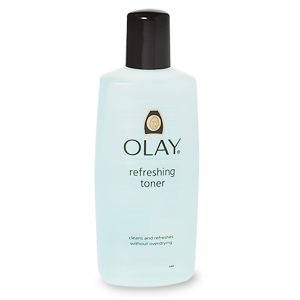
For example, look at Olay Refreshing Toner. It consists primarily of water, alcohol and witch hazel distillate. But modern astringents have moved away from this approach due to the drying effects of the alcohol.

Take a look at NIVEAs Visage Moisturizing Toner - it's an alochol free toner that uses glycerine, a castor oil derivative, and a polymer to do give your skin the same kind of refreshed feeling. We're not saying that one kind of formula is better than the other, we're just trying to inform you about your choices. You'll have to expermient to find out which kind of formuation works for you, but hopefully we've helped you understand how astringents are different from just using plain alcohol.
In response to your third and final question: there is no technical reason that mens' and women's antiperspirants should be priced differntly. Let's chalk that up to the vaguries of marketing!
We hope this helps. Does anyone else have any questions?
Thebeautybrains
(By the way, check out Michelle's blog at Vidafruga for a latina point of view on beauty care.)
Wednesday, April 26, 2006
Beauty Q & A - The Truth About Rebuilding Hair
We've moved!! Check out this post on the new Beauty Brains website.
The Glitterati asks...
What is the deal with "restructuring" treatments for hair? I mean, I get that the vague concept is to "restore proteins" to your hair or some gobbledy-gook, but isn't hair essentially dead? Can a restructuring treatment really force-feed amino acids or whatever into our manes?
And The Left Brain responds...
By the tone of your question, a certain level of skepticism on your part is evident. And it’s a good thing because the idea of being able to slather on a hair restructuring treatment to actually re-form hair is ridiculous. True, hair is made of amino acids and putting them on hair may provide some minor benefit. But it won’t restructure, restore or rebuild the hair.
This would be a bit like trying to repair a weather-worn Kate Spade bag by pouring a basket of thread and fabric on it. Sure, the stylish sack is made of thread and fabric but you can’t just randomly put them on and expect to get a new purse.
It’s the same way with hair and amino acids. To really restructure the hair, the amino acids would have to be chemically arranged in a specific way. This arrangement can only be done in the hair follicle when the hair is growing. After that, nothing can be done except coat the hair with a good conditioner that mitigates some of the signs of damage.
So, what are these restructuring treatments? In essence, they are just glorified rinse-out conditioners. Just take a look at the ingredients.
Here is Tricomin Restructuring Conditioner

Purified Water, Glyceryl Stearate, PEG-100 Stearate, Stearamidopropyl Dimethylamine, Cetyl Alcohol, Propylene Glycol, Stearyl Alcohol, Dimethicone, Triamino Copper Nutritional Complex (see product information for ingredients), Hydroxyethylcellulose, Panthenol, Aloe Vera Gel, Soydimonium Hydroxypropyl Hydrolyzed Wheat Protein, Hydrolyzed Keratin, Citric Acid, Methylparaben, Fragrance, Disodium EDTA, Propylparaben, Peppermint Oil, Tocopheryl Acetate, Cholecalciferol, Retinyl Palmitate, Vegetable Oil, FD&C Blue 1, D&C Red 33
The rules of cosmetic labeling require that ingredients are listed in order of concentration above 1%. In general, the more of an ingredient in the formula, the more impact it has on the product. The ingredients near the end of the list are just put in there to make a nice marketing story or are color, fragrance or preservatives. In the Tricomin formula, some of the main “working” ingredients are Stearamidopropyl Dimethylamine, Cetyl Alcohol, Stearyl Alcohol, and Dimethicone.
But then take a look at a “regular” rinse-out conditioner. Say Pantene Pro-V Conditioner, Smooth and Sleek
Water, Stearyl Alcohol, Cyclopentasiloxane, Cetyl Alcohol, Stearamidopropyl Dimethylamine, Glutamic Acid, Dimethicone, Benzyl Alcohol, Fragrance, Panthenyl Ethyl Ether, EDTA, Panthenol, Methylchloroisothiazolinone, Methylisothiazolinone
Notice any similarities?? The main working ingredients here are Stearyl Alcohol, Cyclopentasiloxane, Cetyl Alcohol, Stearamidopropyl Dimethylamine, and Dimethicone.
Both of these are good conditioners. But the Restructuring Conditioner will not rebuild your hair any better than a standard rinse-out formula. And it certainly won't rebuild your hair better than thread and fabric would rebuild a worn out Kate Spade.
The Glitterati asks...
What is the deal with "restructuring" treatments for hair? I mean, I get that the vague concept is to "restore proteins" to your hair or some gobbledy-gook, but isn't hair essentially dead? Can a restructuring treatment really force-feed amino acids or whatever into our manes?
And The Left Brain responds...
By the tone of your question, a certain level of skepticism on your part is evident. And it’s a good thing because the idea of being able to slather on a hair restructuring treatment to actually re-form hair is ridiculous. True, hair is made of amino acids and putting them on hair may provide some minor benefit. But it won’t restructure, restore or rebuild the hair.
This would be a bit like trying to repair a weather-worn Kate Spade bag by pouring a basket of thread and fabric on it. Sure, the stylish sack is made of thread and fabric but you can’t just randomly put them on and expect to get a new purse.
It’s the same way with hair and amino acids. To really restructure the hair, the amino acids would have to be chemically arranged in a specific way. This arrangement can only be done in the hair follicle when the hair is growing. After that, nothing can be done except coat the hair with a good conditioner that mitigates some of the signs of damage.
So, what are these restructuring treatments? In essence, they are just glorified rinse-out conditioners. Just take a look at the ingredients.
Here is Tricomin Restructuring Conditioner

Purified Water, Glyceryl Stearate, PEG-100 Stearate, Stearamidopropyl Dimethylamine, Cetyl Alcohol, Propylene Glycol, Stearyl Alcohol, Dimethicone, Triamino Copper Nutritional Complex (see product information for ingredients), Hydroxyethylcellulose, Panthenol, Aloe Vera Gel, Soydimonium Hydroxypropyl Hydrolyzed Wheat Protein, Hydrolyzed Keratin, Citric Acid, Methylparaben, Fragrance, Disodium EDTA, Propylparaben, Peppermint Oil, Tocopheryl Acetate, Cholecalciferol, Retinyl Palmitate, Vegetable Oil, FD&C Blue 1, D&C Red 33
The rules of cosmetic labeling require that ingredients are listed in order of concentration above 1%. In general, the more of an ingredient in the formula, the more impact it has on the product. The ingredients near the end of the list are just put in there to make a nice marketing story or are color, fragrance or preservatives. In the Tricomin formula, some of the main “working” ingredients are Stearamidopropyl Dimethylamine, Cetyl Alcohol, Stearyl Alcohol, and Dimethicone.
But then take a look at a “regular” rinse-out conditioner. Say Pantene Pro-V Conditioner, Smooth and Sleek

Water, Stearyl Alcohol, Cyclopentasiloxane, Cetyl Alcohol, Stearamidopropyl Dimethylamine, Glutamic Acid, Dimethicone, Benzyl Alcohol, Fragrance, Panthenyl Ethyl Ether, EDTA, Panthenol, Methylchloroisothiazolinone, Methylisothiazolinone
Notice any similarities?? The main working ingredients here are Stearyl Alcohol, Cyclopentasiloxane, Cetyl Alcohol, Stearamidopropyl Dimethylamine, and Dimethicone.
Both of these are good conditioners. But the Restructuring Conditioner will not rebuild your hair any better than a standard rinse-out formula. And it certainly won't rebuild your hair better than thread and fabric would rebuild a worn out Kate Spade.
Beauty in a Bottle: How do anti-perspirants and deodorants work?
We've moved. Check out the new Beauty Brains website.

Sarah V posts this perspiration puzzle :
Dear Brains: What's the difference between an antiperspirant and a deodorant? What gives?
The Brains respond:
Sara, thanks for probing this pithy perspiration poser! Here’s the real deal - antiperspirants, as the name implies, stop you from perspiring, or sweating. Deodorants simply get rid of odor. Ultimately, both products are trying to do the same thing: stop you from being stinky. But the way they do their deodorizing duty differs.

Before we explain how these products work, let’s talk a little bit about perspiration. It works like this: you sweat and bacteria grow in the moist, warm areas where the sweat collects. When the bacteria grow they “eat” some of the stuff in your sweat (primarily fatty acids) and they “poop” out stuff that smells bad. End result? B.O. (That’s the quick explanation if anyone’s interested in the long version, just let us know and we can dedicate a future post to a more detailed discussion on sweat. Or you can read all about it here. And if you're really interested, read this article about how women crave the smell of men's sweat!)
So, antiperspirants and deodorants offer you two different approaches to fighting smelly bacterial poop. Deodorants contain an active ingredient (Triclosan is most commony used) that prevents the bacteria from growing and devouring your sweat. No bacteria = no body odor. However, you still get Wet Pits (isn’t that Brad Pitt’s brother?)

Antiperspirants, on the other hand, fight the odor problem in a different way. The active ingredients in antiperspirants, typically zinc salts, interact with your sweat glands to stop perspiration. No perspiration = no food for bacteria = no body odor.
Okay, we know what you're thinking, “Isn't it bad for you to plug up your sweat glands like that?” Don’t sweat it. (Ha, that’s a pun – get it?) But seriously, it’s not something you need to worry about. You’re only affecting a small portion of your body’s sweat glands so you’re not interfering with your body’s natural cooling mechanism. But let's save that discussion for another post.
We should also note that antiperspirants do also have some mild anti-bacterial properties, so if you do still sweat little bit not much bacteria will grow.
Oh, and by the way, both antiperspirants and deodorants also contain fragrance to cover up any odor that does sneak through.
So there you have it two different approaches to solving the same problem. Which one should you use? That's really up to you. Are your arm pits sensitive from shaving? You might want to use a deodorant because some antiperspirants can irritate freshly shaven skin. Do you really, really, really swat a lot? Then you might need an antiperspirant to avoid dripping. Do you wear black dresses that get white stains from antiperspirants? A clear deodorant might be the way to go. (There are clear antiperspirants on the market now, let us know if you want to know more about those formulations.
That’s it for this post. Thanks to Sarah for her question. Stay dry out there!

Sarah V posts this perspiration puzzle :
Dear Brains: What's the difference between an antiperspirant and a deodorant? What gives?
The Brains respond:
Sara, thanks for probing this pithy perspiration poser! Here’s the real deal - antiperspirants, as the name implies, stop you from perspiring, or sweating. Deodorants simply get rid of odor. Ultimately, both products are trying to do the same thing: stop you from being stinky. But the way they do their deodorizing duty differs.

Before we explain how these products work, let’s talk a little bit about perspiration. It works like this: you sweat and bacteria grow in the moist, warm areas where the sweat collects. When the bacteria grow they “eat” some of the stuff in your sweat (primarily fatty acids) and they “poop” out stuff that smells bad. End result? B.O. (That’s the quick explanation if anyone’s interested in the long version, just let us know and we can dedicate a future post to a more detailed discussion on sweat. Or you can read all about it here. And if you're really interested, read this article about how women crave the smell of men's sweat!)
So, antiperspirants and deodorants offer you two different approaches to fighting smelly bacterial poop. Deodorants contain an active ingredient (Triclosan is most commony used) that prevents the bacteria from growing and devouring your sweat. No bacteria = no body odor. However, you still get Wet Pits (isn’t that Brad Pitt’s brother?)

Antiperspirants, on the other hand, fight the odor problem in a different way. The active ingredients in antiperspirants, typically zinc salts, interact with your sweat glands to stop perspiration. No perspiration = no food for bacteria = no body odor.
Okay, we know what you're thinking, “Isn't it bad for you to plug up your sweat glands like that?” Don’t sweat it. (Ha, that’s a pun – get it?) But seriously, it’s not something you need to worry about. You’re only affecting a small portion of your body’s sweat glands so you’re not interfering with your body’s natural cooling mechanism. But let's save that discussion for another post.
We should also note that antiperspirants do also have some mild anti-bacterial properties, so if you do still sweat little bit not much bacteria will grow.
Oh, and by the way, both antiperspirants and deodorants also contain fragrance to cover up any odor that does sneak through.
So there you have it two different approaches to solving the same problem. Which one should you use? That's really up to you. Are your arm pits sensitive from shaving? You might want to use a deodorant because some antiperspirants can irritate freshly shaven skin. Do you really, really, really swat a lot? Then you might need an antiperspirant to avoid dripping. Do you wear black dresses that get white stains from antiperspirants? A clear deodorant might be the way to go. (There are clear antiperspirants on the market now, let us know if you want to know more about those formulations.
That’s it for this post. Thanks to Sarah for her question. Stay dry out there!
Tuesday, April 25, 2006
Beauty Buzz: Hair Growth Laser Comb?
We've moved!! Check out the all new Beauty Brains website.
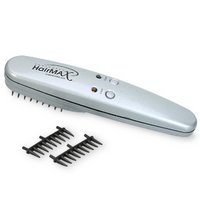
Wow, check out this cool Laser Comb that makes your hair healthier!
At least that's what the good people over at HairMax are saying.
According to their website, the HairMax LaserComb harness the power of "Photo-Biostimulation" aka Low Light Laser Therapy, aka LLLT, to improve the appearance of your hair over time. (And it's a STEAL at only $545 over at Drugstore.com!)
"Wow," you're thinking.
"Sounds too good to be true," you say softly to yourself.
You're probably right.
The Brains got suspicious when they read that the Lasercomb works because "Light is energy. Living cells thrive in light and your hair is no different. "
Umm, actually hair IS different. It's dead! That part about hair cells thriving in light? That's crap. If anything, certain frequencies of light are damaging to hair!
So right off the bat, the Hair Max staff have lost some credibility for not understanding basic hair biology. We don't know of any scientific mechanism that would explain how the application of light could improve the condition of hair.
But wait, it gets better... If you read the website carefully you won't see any direct claims about promoting hair growth or preventing hair loss. BUT - if you browse around, you WILL see 16 pictures that show much hair growth their customers had "before and after" using the LaserComb. So they're certainly IMPLYING hair growth claims!
Now, as I'm sure you're wondering: "Doesn't the FDA monitor hair growth claims? What do they have to say about this?"
Good question! Here's a quote from the FDA's website:
So what does the FDA say about the use of LLLT for hair treatment or growth? Nada. Zip. Zero. Zilch.
Sooo, we dont' know about you, but we'd certainly want some kind of evidence this thing works before shelling out 500 bucks! The Brains say: Let the buyer beware!
If anyone has tried this thing, let us know!

Wow, check out this cool Laser Comb that makes your hair healthier!
At least that's what the good people over at HairMax are saying.
According to their website, the HairMax LaserComb harness the power of "Photo-Biostimulation" aka Low Light Laser Therapy, aka LLLT, to improve the appearance of your hair over time. (And it's a STEAL at only $545 over at Drugstore.com!)
"Wow," you're thinking.
"Sounds too good to be true," you say softly to yourself.
You're probably right.
The Brains got suspicious when they read that the Lasercomb works because "Light is energy. Living cells thrive in light and your hair is no different. "
Umm, actually hair IS different. It's dead! That part about hair cells thriving in light? That's crap. If anything, certain frequencies of light are damaging to hair!
So right off the bat, the Hair Max staff have lost some credibility for not understanding basic hair biology. We don't know of any scientific mechanism that would explain how the application of light could improve the condition of hair.
But wait, it gets better... If you read the website carefully you won't see any direct claims about promoting hair growth or preventing hair loss. BUT - if you browse around, you WILL see 16 pictures that show much hair growth their customers had "before and after" using the LaserComb. So they're certainly IMPLYING hair growth claims!
Now, as I'm sure you're wondering: "Doesn't the FDA monitor hair growth claims? What do they have to say about this?"
Good question! Here's a quote from the FDA's website:
"Biostimulation lasers, also called low level laser therapy (LLLT), cold
lasers, soft lasers, or laser acupuncture devices, were cleared for
marketing by FDA through the Premarket Notification/510(k) process as
adjunctive devices for the temporary relief of pain."
So what does the FDA say about the use of LLLT for hair treatment or growth? Nada. Zip. Zero. Zilch.
Sooo, we dont' know about you, but we'd certainly want some kind of evidence this thing works before shelling out 500 bucks! The Brains say: Let the buyer beware!
If anyone has tried this thing, let us know!
Sunday, April 23, 2006
Actual Ads: More Animal Protein!
This blog has moved!!! Check out the all new Beauty Brains.
Ahh, how times change.
Today, amid fears of Mad Cow Disease and Bird Flu, the mere HINT that a product contains any animal by products is even to send even the zealous fan of cosmetics shrieking into the night. But not so back in the 1970s, no sir! Back then we embraced our animal by products. Case in point, this Clairol Condition ad from 1974. Read the fine print carefully - "It contains more animal protein than any leading conditioner." Now there's a claim you don't see anymore!
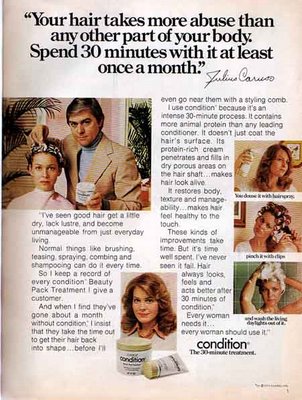
copyright 1974, Clairol Inc.
Ahh, how times change.
Today, amid fears of Mad Cow Disease and Bird Flu, the mere HINT that a product contains any animal by products is even to send even the zealous fan of cosmetics shrieking into the night. But not so back in the 1970s, no sir! Back then we embraced our animal by products. Case in point, this Clairol Condition ad from 1974. Read the fine print carefully - "It contains more animal protein than any leading conditioner." Now there's a claim you don't see anymore!

copyright 1974, Clairol Inc.
Beauty Q & A: What about Natural Cleansers?
Starrynight wants to know:
Marie Clair's website has an article about natural cleansers.
The article says that shampoos formulated with natural cleansers like Aveda, Phyto and Ojon are better for your hair than other brands. What do you say about that?
The Brains Respond:
Here's a quote from the article Starry mentions...
Aveda (Rosemary Mint shampoo)
Sodium Coco-Sulfate (as known as Sodium Lauryl Sulfate or Laureth Sulfate) Lauramidopropyl Betaine (essentially same as cocamidopropyl b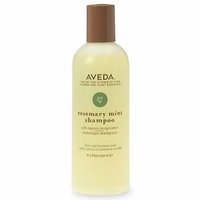 etaine)
etaine)
Cocamidopropylamine Oxide
Phyto (Phytocitrus Shampoo)
Sodium Laureth Sulfate
Coco Betaine (same as cocamidopropyl betaine)

Ojon Ultra Hydrating Shampoo
Magnesium Laureth Sulfate (same base molecule as Sodium Laureth Sulfate)
Cocamidopropyl Betaine
Disodium Laureth Sulfosuccinate
Lauryl Glucoside
Glyceryl Oleate
Now let's look at a few products with "non-natural" cleansers:
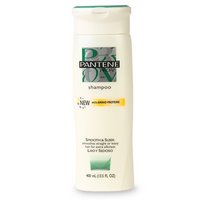
Pantene (Smooth and Sleek)
Ammonium Laureth Sulfate
Ammonium Lauryl Sulfate
Cocamide MEA
Tresemme (Vitamin E Moisture Rich)
Sodium Laureth Sulfate
Cocamidopropyl Betaine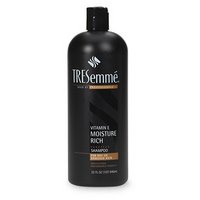
Yes, there are a lot of chemical names here, but you don't have to be a scientist to recognize that all of these products have either "sulfate" type of cleansers , "betaine" type of cleansers, or some combination. These cleansers can be derived from coconut oil, so in that sense they are "natural" but as you can see, the very expensive "natural" products and the less expensive "regular" products basically use the same types of cleansers!
Now, that's not to say that there is NO difference between shampoo formulas. The amount of cleansers in the formula and the conditioning ingredients they are blended with can make a tremendous difference. So, we're not saying any of these products are better or worse than any of the others. (Try them for yourself to find out!) But what we are saying is (and here's the important part:) None of these products are more NATURAL than the others. That's the true science! Buy what ever brand you like, but if you're buying these brands because the company tells you that they are more natural, then you're being mislead. We hope this helps!
Anybody else got a question?
Leave a post or email us at Thebeautybrains@gmail.com.
Marie Clair's website has an article about natural cleansers.
The article says that shampoos formulated with natural cleansers like Aveda, Phyto and Ojon are better for your hair than other brands. What do you say about that?
The Brains Respond:
Here's a quote from the article Starry mentions...
"All shampoos contain cleansers," explains Christyn Nawrot, a regional educator for Phyto. But those with naturally derived cleansers are less apt to rob your hair of vital oils. (Phyto, Lavett & Chin, Ojon and Aveda use natural cleansers in all of their shampoos.)"Hoo boy! This is the kind of question the Brains just love! Natural is one of the buzz words in this industry that doesn't mean very much. Let's take a look at the "natural" cleansers in the products mentioned in the Marie Claire article. (To make it easy, we're just listing the cleansers, but you can look at the entire ingredient list at drugstore.com):
Aveda (Rosemary Mint shampoo)
Sodium Coco-Sulfate (as known as Sodium Lauryl Sulfate or Laureth Sulfate) Lauramidopropyl Betaine (essentially same as cocamidopropyl b
 etaine)
etaine)Cocamidopropylamine Oxide
Phyto (Phytocitrus Shampoo)
Sodium Laureth Sulfate
Coco Betaine (same as cocamidopropyl betaine)

Ojon Ultra Hydrating Shampoo

Magnesium Laureth Sulfate (same base molecule as Sodium Laureth Sulfate)
Cocamidopropyl Betaine
Disodium Laureth Sulfosuccinate
Lauryl Glucoside
Glyceryl Oleate
Now let's look at a few products with "non-natural" cleansers:

Pantene (Smooth and Sleek)
Ammonium Laureth Sulfate
Ammonium Lauryl Sulfate
Cocamide MEA
Tresemme (Vitamin E Moisture Rich)
Sodium Laureth Sulfate
Cocamidopropyl Betaine

Yes, there are a lot of chemical names here, but you don't have to be a scientist to recognize that all of these products have either "sulfate" type of cleansers , "betaine" type of cleansers, or some combination. These cleansers can be derived from coconut oil, so in that sense they are "natural" but as you can see, the very expensive "natural" products and the less expensive "regular" products basically use the same types of cleansers!
Now, that's not to say that there is NO difference between shampoo formulas. The amount of cleansers in the formula and the conditioning ingredients they are blended with can make a tremendous difference. So, we're not saying any of these products are better or worse than any of the others. (Try them for yourself to find out!) But what we are saying is (and here's the important part:) None of these products are more NATURAL than the others. That's the true science! Buy what ever brand you like, but if you're buying these brands because the company tells you that they are more natural, then you're being mislead. We hope this helps!
Anybody else got a question?
Leave a post or email us at Thebeautybrains@gmail.com.
Saturday, April 22, 2006
Skin Lotion Posts
1) Are La Mer and Kerastase Worth It?
2) Why Do I Need To Use Facial Lotion?
3) Facial Creams and Moisturizers
4) How Skin Lotions Work: Part 1
5) Advances for Making Anti-Aging Lotions
6) What's Making Your Skin Red?
7) Do Shave Minimizing Lotions Work?
8) Does mineral oil cause zits?
10) What's a Good Facial Sunscreen?
11) What To Do For Dry Skin and Breakouts?
12) Do Tattoo Fade Creams Work?
13) Do Dry Skin Products Make Skin Oily?
14) Does Over-Moisturizing Dry Out Your Skin?
2) Why Do I Need To Use Facial Lotion?
3) Facial Creams and Moisturizers
4) How Skin Lotions Work: Part 1
5) Advances for Making Anti-Aging Lotions
6) What's Making Your Skin Red?
7) Do Shave Minimizing Lotions Work?
8) Does mineral oil cause zits?
10) What's a Good Facial Sunscreen?
11) What To Do For Dry Skin and Breakouts?
12) Do Tattoo Fade Creams Work?
13) Do Dry Skin Products Make Skin Oily?
14) Does Over-Moisturizing Dry Out Your Skin?
Conditioner Posts
1) Garnier's Fructis Fortifying Cream Conditioner
2) Are Moisture and Protein Good for Overprocessed Hair?
3) Are Proteins Good Conditioners?
4) The Truth About Rebuilding Hair
5) Pantene Restoratives Review
6) How Is Hair Breakage Measured?
7) Biosilk Conditioner Review
8) Is Ojon Restorative Treatment Any Good?
9) Can I Really Repair Split Ends?
10) Do Sunscreens Work on Hair?
11) Are salon products in regular stores the same as those bought in salons
12) Is it ok to mix hair care products?
13) Does Malibu Treatment Remove Hard Water and Rust Stains from Hair?
14) Does Heat Protection Help Hair?
15) Is Pantene Good Or Bad For My Hair?
2) Are Moisture and Protein Good for Overprocessed Hair?
3) Are Proteins Good Conditioners?
4) The Truth About Rebuilding Hair
5) Pantene Restoratives Review
6) How Is Hair Breakage Measured?
7) Biosilk Conditioner Review
8) Is Ojon Restorative Treatment Any Good?
9) Can I Really Repair Split Ends?
10) Do Sunscreens Work on Hair?
11) Are salon products in regular stores the same as those bought in salons
12) Is it ok to mix hair care products?
13) Does Malibu Treatment Remove Hard Water and Rust Stains from Hair?
14) Does Heat Protection Help Hair?
15) Is Pantene Good Or Bad For My Hair?
Beauty Q & A: Are Proteins Good?


ligirl217 over at Lucky.com posted the following comment:
I use rusk's smoother shampoo and calm conditioner. I would not buy my hair products at a drug store because they are loaded with stuff that makes you feel like your hair is silkier but it actually does nothing to solve the problem with keeping your hair in good condition. I use a deep conditioner by the brand Italy which makes hair dye and is sold at my salon...this thing is god sent because my hair is AMAZING after I use it (once a week). Here's a trick: when shopping for both shampoo and conditioner, make sure to read the ingredients and look for silk or wheat proteins...it's the key to healthy hair!
The Brains Respond:
Ligirl217: We'd love to find out exactly which "Italy" deep conditioner you're using, we're not very familiar with that brand. However, we are very familiar with conditioner formulations so here's the real scoop. First of all, from a scientific standpoint, there's nothing inherently different about drug store conditioners. It is NOT true that they use ingredients that are very different than most of the salon or department store brands. There are good and bad products in drug stores and there are good and bad products in salons. Where you buy the product doesn't tell you ANYTHING about how good it is!
Now let's address your second point about looking for silk or wheat proteins because they are the key to healthy hair. Although your hair is made of protein, protein doesn't do much when added to your hair from shampoo or conditioner. The other conditioning agents in the formula are what smooth the cute coal and protect your hair from damage.
There's nothing wrong with using expensive salon brands and looking for ingredients that you like. But just remember, there's a lot of advertising hype in this industy so be careful. The more you know the truth about your products, the better shopper you'll be!
Anybody else have any questions?
Shampoo Posts
1) How Do Shampoos Work? Part 1
2) How Do Shampoos Work? Part 2: Mixing
3) How Do Shampoos Work? Part 3: Interaction with Hair
4) What to do for Greasy Hair?
5) Do Curling Shampoos Really Work?
6) Why Does My Shampoo Stop Working?
7) More on shampoo build-up
8) What about Natural Cleansers?
9) Too Many Choices in the Shampoo Aisle Part1
10) Too Many Shampoo Choices Part 2
11) Are Hair Products Bad for your Hair?
12) Worst Shampoo Ingredients Ever!
13) No Rinse Shampoo
14) Placenta Shampoo
2) How Do Shampoos Work? Part 2: Mixing
3) How Do Shampoos Work? Part 3: Interaction with Hair
4) What to do for Greasy Hair?
5) Do Curling Shampoos Really Work?
6) Why Does My Shampoo Stop Working?
7) More on shampoo build-up
8) What about Natural Cleansers?
9) Too Many Choices in the Shampoo Aisle Part1
10) Too Many Shampoo Choices Part 2
11) Are Hair Products Bad for your Hair?
12) Worst Shampoo Ingredients Ever!
13) No Rinse Shampoo
14) Placenta Shampoo
Friday, April 21, 2006
Beauty in a Bottle: How Do Shampoos Work? Part 1
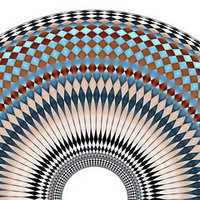
Let's break down the question into three parts:
This first post will define what ingredients are used in shampoos, the second part will describe how the formula is manufactured, and the third part will explain how the product actually works on hair.
Part 1: Shampoo ingredients can be broken down into the following basic categories:
Surfactants
Surfactants are the primary functional ingredients in shampoo. A surfactant is simply a type of detergent. Although sometimes surfactants are referred to as soaps, this is not exactly accurate. A soap is a special type of surfactant, but not all surfactants are soaps. Surfactants make the shampoo foam; they also dissolve grease and oil from your hair. Surfactants are commonly used in almost every type of cleansing product, from toothpaste to hand soap to body wash.
Thickeners
Shampoos are typically thickened by a reaction between the surfactants and salt. Formulators may also add special thickening agents known as polymers.
Preservatives
Preservatives are added to the formula to ensure the product doesn't become contaminated by bacteria, mold, or yeast. Common preservatives include parabens and urea derivatives.
Color
A variety of dyes maybe added to the shampoo to impart a pleasing color. In the vast majority of shampoos, the dye has no functional purpose at all - it's just there to make the shampoo look nice. There is a special sub-class of shampoos that are color-depositing. They contain special staining dies that can help give the hair a little bit of color.
Conditioning agents
A good shampoo not only cleans the hair, it moisturizes as well. The conditioning agents used in shampoos are typically polymers such as those derived from cellulose or guar, or silicones. Typically the silicone must be chemically modified to be soluble in the shampoo system. Two - in -1- shampoos have higher levels of conditioning agents so a separate rinse out conditioner is not required.
Control agents
Control agents are added to the formula to help adjust its physical properties. For example, an acid or base may be added to raise or lower the pH. Thickeners, as the name implies, control how thick or thin the product is. (The scientific term for this measurements a is "viscosity.")
Fragrance - fragrance is extremely important to a shampoo. In addition to covering the chemical odor of the product, a good fragrance support the image of the product. For example, research shows that consumers think a deep cleansing shampoo works better when it has a citrus fragrance. Moisturizing shampoos seem to condition better when they have a rich, "milky" fragrance. In future posts we'll deal with the impact of fragrances in cometics in more detail.
Featured ingredients
Marketers frequently add featured ingredients to their formulations to make them more appealing or to support to a certain marketing story. In the deep cleansing shampoo example described above, one would expect to find a citrus extracts like tangerine peel or lemon zest in the formula. While these ingredients do serve to make the product more appealing, they typically do not perform any function.

Now that you have a fundamental understanding of what goes in a shampoo, you're ready to learn about how these ingredients are put together into a finished product. Look for Part 2 of "How Are Shampoos Made" in a future post.
Thursday, April 20, 2006
Beauty Q & A: Are Moisture and Protein Good for Overprocessed Hair?
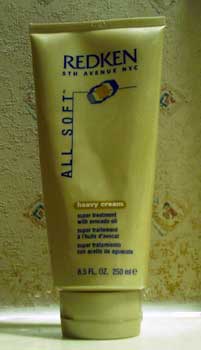
Cynical Girl sez...
I have a two-part question:
I have over-highlighted my hair and it's fried. The salon recommended a Redken All Soft conditioning treatment and another Redken protein treatment.
1) Will any of these products really make a difference, or do I just need to cut off the damaged ends of my hair?
2) Is it possible to add too much moisture or protein to my hair? Any risks?
The Beauty Brains Respond:
Cynical Girl - it looks like you've committed the cardinal sin of chemically caring for your hair: you over-processed. But, rather than publicly berating you here on the blog, we'll give you some information that will help save your hair.
Your stylist recommended a couple of Redkin products. There's certainly nothing wrong with using those - the All Soft conditioner is a fine product that could mitigate some of the damage you've done to your hair. I'm not really sure you would necessarily need to use the protein treatment since protein aren't typically a significant active ingredient in conditioner formulas. Although your hair is made of protein (keratin protein to be precise), protein delivered from a conditioner doesn't really help that much. There are other conditioning and moisturizing agents that are more beneficial to your hair than proteins. Still, if you don't mind spending the money on those Redkin products they're certainly worth a shot.
You just need to be careful that you don't over condition your hair or else you might end up with limp lifeless locks. Which leads us to the second part of your question. Can you add too much moisture or protein to your hair? The answer is: "Not exactly." Let us explain.
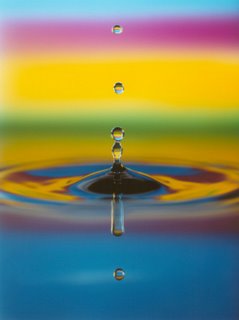
One of the components of your hair is moisture - in fact your hair naturally contains between 8 and 14 percent water. But, and here is the tricky part, your hair naturally equilibrates to the humidity in your environment. In other words if it's very dry outside you will have less moisture than 8 to 14 percent in your hair and if it's very humid you'll have more. Think about your hair after you wash it or after you've gone swimming. It doesn't stay wet - it eventually does dry out.
On the other hand, you do need to watch out for adding too much moisturizer. A moisturizer is an ingredient that helps your hair hold onto moisture. Strictly speaking, moisture is water but moisturizers can be oils or silicones. And if you put too much of these materials on your hair you can get on build up or weigh down effect, which is not good, especially if you want your hair to look thick and full.
The Brain's Bottom line:
The Brains don't discourage you from trying the Redkin products, but you may find you don't like them. If this happens, you'll have to experiment with a few other conditioners to find one that gives you the right balance of moisture without weighdown. But at least now, hopefully we've given you have a better understanding of HOW your conditioner works. And by the way, don't you dare wash your hair without conditioning - at least for the next few weeks. You've got to protect your fragile, over-processed strands.
We hope this helps, thanks for asking The Brains!
Anybody else got a question? Email us at Thebeautybrains@gmail.com.
Actual Ads: Thrilling Beauty News - Liquid Shampoo!
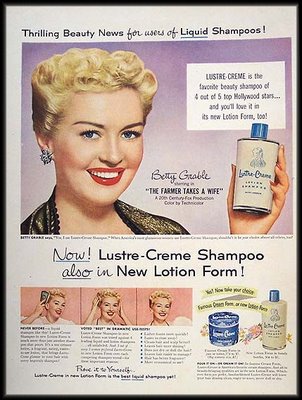
Here are our 3 favorite things about this old ad:
1) The step-by-step picture diagram showing you how to comb your hair (in case you don't have a mirror, I guess).
2) The fact that the product is in a GLASS bottle. (Wet shower + slippery foam + breakable glass bottle = trip to emergency room.)
3) The way they make such a big deal about the shampoo NOW! being available in a liquid, lotion form. What were they using before? Powdered shampoo?? Bar soap?? (Yeah, maybe they were, this ad is pretty old!)
Wednesday, April 19, 2006
Category List - Under Construction
We're working on this section and we'll announce when it's ready to use. Thanks!
Beauty Q & A: Are La Mer and Kerastase Worth It?
Natasha said...
We're also told that it's hyper-rich in concentrated ingredients ranging from sea kelp, calcium, magnesium, potassium, iron, lecithin, Vitamins C, D, E and B12, plus oils of citrus, eucalyptus, wheat germ, alfalfa and sunflower. Unfortunately, there's very little hard data to show that any of these ingredients will miraculously heal your skin.
Is it a good moisturizer?
Yes.
Is it worth it?
Well, if you LIKE the product and you can afford it, then it's worth it to you. BUT if you're just disatisfied with your current products and you think that by spending a LOT more money you'll get a LOT better performance, then no, it's probably not worth it. But don't just take our word for it, check out the reviews of La Mer at Makeup Alley.
Now on to Kerastase:
Let's look at their Nutritive Bain Satin 3 shampoo as an example.
This product sells for $26.00 for 8.45 oz at Cosmeticmall.com.
It claims to be for very dry and damaged hair... it smoothes the hair fibre, intensely nourishes and neutralises static it leaves your hair soft and tangle free. These are pretty basic hair care claims; any good conditioning shampoo will perform these same functions.
If you're in love with the texture or the fragrance and you've got $26 bucks to spend on shampoo, then by all means - enjoy! But if you're on a budget, there are plenty of good mass market shampoos that can do the job just as well.
Check out these reviews for more info...
So, Natasha, to answer your question: these expensive products will probably give you very nice results. But they won't give you technically better results than high quality products that are much cheaper. Thanks for asking The Brains!
Anybody else have a question?
I wanted to know if high priced creams such as La Mer and Kerastase hair products have better results than what you may find cheaper or at a drug store.
The Brains Respond:
Natasha, thanks for the question! Let's tackle the skin side first with Creme de la Mer:
We're also told that it's hyper-rich in concentrated ingredients ranging from sea kelp, calcium, magnesium, potassium, iron, lecithin, Vitamins C, D, E and B12, plus oils of citrus, eucalyptus, wheat germ, alfalfa and sunflower. Unfortunately, there's very little hard data to show that any of these ingredients will miraculously heal your skin.
Is it a good moisturizer?
Yes.
Is it worth it?
Well, if you LIKE the product and you can afford it, then it's worth it to you. BUT if you're just disatisfied with your current products and you think that by spending a LOT more money you'll get a LOT better performance, then no, it's probably not worth it. But don't just take our word for it, check out the reviews of La Mer at Makeup Alley.
Now on to Kerastase:
Let's look at their Nutritive Bain Satin 3 shampoo as an example.
This product sells for $26.00 for 8.45 oz at Cosmeticmall.com.
It claims to be for very dry and damaged hair... it smoothes the hair fibre, intensely nourishes and neutralises static it leaves your hair soft and tangle free. These are pretty basic hair care claims; any good conditioning shampoo will perform these same functions.
If you're in love with the texture or the fragrance and you've got $26 bucks to spend on shampoo, then by all means - enjoy! But if you're on a budget, there are plenty of good mass market shampoos that can do the job just as well.
Check out these reviews for more info...
So, Natasha, to answer your question: these expensive products will probably give you very nice results. But they won't give you technically better results than high quality products that are much cheaper. Thanks for asking The Brains!
Anybody else have a question?
Beauty News Bits - Making Brown Eyes Blue

Beauty News Bits – Make your brown eyes blue.
The folks over at C&E News are reporting on a new technology for changing your eye color. Researchers at Ciba Vision and Bausch & Lomb have come up with a new way to change eye color that works much better than the current technology. While colored lenses have been around since the 1970’s, they haven’t worked well for making brown eyes look naturally blue. But now by using nanotechnology (really really tiny particles) and inspiration from the wings of butterflies, even the darkest brown eyes can be made blue. And it won’t even require a breakup with your boyfriend.
Beauty Biology: What is hair made of?

Hair is primarily made of a special type of protein called "keratin." Keratin is the same tough, water insoluble material that fingernails and animal horns and hooves are made of. Hair also contains natural oils (lipids) and water. These hair "ingredients" are arranged in 3 primary structures: the cuticle (which is the outermost, shingle-like layer); the cortex (the inside of the hair consisting of bundles of protein filaments; and the medula (a soft spongy-like core in the center of the cortex.)
Tuesday, April 18, 2006
Beauty Q & A: What to do for Greasy Hair?

Becky in Dubuque asks the following question:
"What shampoo is good for a little kid with very greasy hair?"
"My daughter, who's five years old, gets very greasy hair over the course of the day. I wash it every morning, but by late in the afternoon it's so greasy and smelly that I have to wash it again. I tried using a dandruff shampoo, and it did make her hair less greasy. But, it also made her scalp flake. I've been using a good degreasing shampoo, so the hair is getting clean, but it seems to get greasy again so quickly. What can I do?"
The Beauty Brains respond:
Becky, this case is a bit tricky. Since your daughter's greasy hair problem did respond to treatment with a dandruff shampoo we suggest in exploring that avenue and experimenting a little further. If using a dandruff shampoo every day cured her greasiness, but caused her scalp to flake, why not try using the dandruff shampoo less frequently? We'd suggest using a good dandruff shampoo, like the Head and Shoulders, every other time you shampoo. If you still get flakes then try it every two shampoos. So one day use your regular shampoo, the next day use your dandruff shampoo, and so on. If the problem persists, you'd better see your pediatrician! Let us know if this helps!
Anybody else have a question? Email the Beauty Brains at thebeautybrains@gmail.com.
How do these products work?
Here at the Beauty Brains we review the chemistry behind the beauty products you use everyday. We look at what they're made of, how they work, and why you should use (or not use) them. Below is a list of the product forms we have reviewed previously.
If you have requests for product reviews you'd like to see, please leave a note in the comments.
Shampoos
1. Beauty in a Bottle: How Do Shampoos Work - Part 1
2. Beauty in a Bottle: How Do Shampoos Work - Part 2
3. Beauty in a Bottle: How Do Shampoos Work - Part 3
4. Do Curling shampoos work?
Conditioners
Coming soon
Antiperspirants / Deodorants
1. How do anti-perspirants and deodorants work?
Skin Lotions
1. How do skin lotions work? - Part 1
2. How do shave minimizing lotions work?
Cleansers
Coming soon
Make-up
1. How does mascara work?
Others
1. How do sunless tanners work?
2. How do those teeth whitener products work?
3. How do pore strips work?
If you have requests for product reviews you'd like to see, please leave a note in the comments.
Shampoos
1. Beauty in a Bottle: How Do Shampoos Work - Part 1
2. Beauty in a Bottle: How Do Shampoos Work - Part 2
3. Beauty in a Bottle: How Do Shampoos Work - Part 3
4. Do Curling shampoos work?
Conditioners
Coming soon
Antiperspirants / Deodorants
1. How do anti-perspirants and deodorants work?
Skin Lotions
1. How do skin lotions work? - Part 1
2. How do shave minimizing lotions work?
Cleansers
Coming soon
Make-up
1. How does mascara work?
Others
1. How do sunless tanners work?
2. How do those teeth whitener products work?
3. How do pore strips work?
Monday, April 17, 2006
Beauty News: Zit Zapper

Looking for a better way to cure your acne? Check this out - a new laser can permanently eliminate zits! Professor Rox Anderson with Harvard Medical School, Boston, has developed a technique that uses a laser to melt fat deposits below the skin. In theory, this same technique could destroy the over active sebaceous glands that cause pimples. Human tests could begin as early as next year, so stay tuned.
Sunday, April 16, 2006
Beauty Q & A: Where can I buy cosmetics?

Carrie S. in Seattle writes in with this question:
"I've always heard that drug stores and department stores carry better quality cosmetics than grocery stores. Is this true?"
The Beauty Brains respond:
Well, Carrie, in some ways it's true and in others it's not. In general, you can buy more upscale products in drug and department stores. Perfumes, for example. And you may want to pay more for fancy packaging for your cosmetic products so they look better in your bathroom or on your dresser. You'll find a wider range of options in drug and department stores for those as well.
But in terms of the basic functional performance of products that you use, you won't see a tremendous difference if you're comparing products of similar quality. Take hair care for example, Suave and Pantene are both sold in drug stores and in food chains. You will see a difference if you're comparing Suave to Pantene. But it's very unlikely that you'll see a performance difference between Pantene and a much more expensive brand that the grocery store doesn't carry.
The trick is to look for quality products wherever you shop and buy what you can afford. You don't always get a better product just because it costs more. If you'd like to ask us about any specific products for hair or skin, let us know and we can give you the "Science Scoop."
Hope this helps!
Anybody Else Got Questions?
Email us at Thebeautybrains@gmail.com
Saturday, April 15, 2006
Article Review: Diet Doesn't Do It

The Beauty School section on Seventeen Magazine's website has an article about putting your hair on a diet to make it shinier. The article points out that "you can repair damage" to your hair if you "use the right styling products for your hair type and nourish your body from the inside out."
There's no question that a good diet is an important part of a healthy lifestyle and Seventeen should be applauded for emphasizing that fact to their readership. However, The Beauty Brains are compelled to point out for most people, changing your diet will NOT change the quality of your hair. All the published scientific research shows that, except in cases of SEVERE malnutrition, a change in diet has little impact on basic hair properties like shine, strength, and elasticity.
The mission of The Beauty Brains is to educate you on the true science of beauty products so you have a chance of understanding all the hype that the cosmetic companies throw at you. There are a lot of good products out there - we're here to help you wade through all the crap so you can find the ones right for you.
Wednesday, April 12, 2006
Beauty Review: Fructis Fortifying Cream Conditioner

Let's take a look at Garnier's Fructis Fortifying Cream Conditioner.
This product is appropriately positioned for "normal" hair, in other words, hair that doesn't need intensive conditioning. (That means you don't color or highlight or any other kind of chemical processing!) So, if you need a moderate level of conditioning and you like bright fruity fragrances, then you should give it a try.
The most interesting aspect of the product is its claim about Active Fruit Concentrate. The back of the bottle states that the concentrate is "the innovative combination of ingredients naturally present in fruit: fruit acids, vitamins B3 and B6, Fructose and Glucose." Here's where The Beauty Brains' reality lesson kicks in: there is no scientific data to show that these fruit ingredients do ANYTHING for your hair. Now, that's not to say that this isn't a fine formula. In fact, it uses some rather sophisticated conditioning agents, like behenitrimonium chloride. (That might sound scary, but it's actually good for your hair!) Anyway, the effect on your hair comes from this kind of ingredient NOT from the Active Fruit Concentrate. Most companies play this game to some degree - they add ingredients to a formula that give the product a sexy, hip image. There's nothing wrong with that! That's what Marketing is all about - BUT they do have to be careful to present it in a way that's not misleading to the consumer.
So, congrats to Garnier (which by the way is a division of L'Oreal) for developing a great smelling, solid performing formula - but shame on them for not being a little more careful with their claims.
PS: Garnier takes a very "science-y" approach with this brand - they even include some pictures and graphs on the back of the bottle to show how it works. Some other time we'll talk about how they support their strength and shine claims. Meanwhile, drop us a line if you have any questions.
Tuesday, April 11, 2006
Ironic Beauty - What about hair?
An interesting observation made in a New York subway station. It's a funny reminder to everyone to think about the messages you hear from advertisers everyday.
Beauty News - Body and the Beasts
It seems the folks over at The Body Shop are feeling the heat after a supposed "sell out" to corporate giant L'Oreal. The Guardian is reporting lost sales due to a consumer backlash.
From the article ...
Ethical Consumer magazine told its readers to boycott Body Shop because L'Oreal tests products on animals. L'Oreal says it does so in line with international regulations.
This kind of bullying by Advocate groups is unfortunate. The truth is every cosmetic and personal care product (or every ingredient in them) you use has at some point been tested on animals. There are no ethical companies that can sell products that haven't been tested!
Now if people were boycotting because of the outrageously high prices charged by the Body Shop, that would be more understandable. $12 for 8 ounces of shampoo is just ridiculous!
From the article ...
Ethical Consumer magazine told its readers to boycott Body Shop because L'Oreal tests products on animals. L'Oreal says it does so in line with international regulations.
This kind of bullying by Advocate groups is unfortunate. The truth is every cosmetic and personal care product (or every ingredient in them) you use has at some point been tested on animals. There are no ethical companies that can sell products that haven't been tested!
Now if people were boycotting because of the outrageously high prices charged by the Body Shop, that would be more understandable. $12 for 8 ounces of shampoo is just ridiculous!
Beauty Bits: News Of The Day

Remember Revlon?
According to Yahoo Financial News, Revlon is staging a major product push aimed at women over 50. Click here to read about new products for the nifty fifties.
Monday, April 10, 2006
Beauty Booster: New Product Alert

Strip for more beautiful hair?
Here's an interesting new product - Charles Worthington's H2O Styling Strips, water activated gel strips for styling hair.
Just take one between the palms of your hands, add a splash of warm water, and rub to activate. Then spread through your hair to give it body and lasting hold. The strips are even packaged in a convenient 'pocket pack' like breath strips. While The Beauty Brains haven't tested this product yet, we do applaude the innovative use of delivery technology. If anyone has used them, drop us a line with your comments at Thebeautybrains@gmail.com!
Beauty Bits: News Of The Day
According to Beauty-on-line.com, the drug store chain CVS may be more strict than the federal government when it comes to what it allows in cosmetics. See the article titled "Shareholders coalition press CVS to remove some cosmetics from shelves" Click here if you're a CVS shopper.
Sunday, April 09, 2006
Beauty Bits: News of the Day
The Hairstyler.com has an interesting way to classify the shape of your face. I don't know if it really helps you pick your hairstyle, but it is interesting to find out if you're a heart face, diamond face or Triangular face type.
Face it here!
Face it here!
Friday, April 07, 2006
Beauty Bits: News Of The Day

Something smells fishy here...oh wait, it's just my new lotion.
According to Cosmeticsdesign.com, researchers from the Norwegian University of Science and Technology have discovered that fish enzymes can be good for your skin because of the way they can break down dead skin cells without harming live ones. Hmmm, clever and not entirely surprising since other natural extracts (papaya comes to mind) have similar properties.
Thursday, April 06, 2006
Beauty Bits: News of the Day
Sun Tan Junkies Get Runner's High
Wanna get high on light...uh, I mean life? Click here.
Wanna get high on light...uh, I mean life? Click here.
Wednesday, April 05, 2006
Tuesday, April 04, 2006
Beauty Bits: News Of The Day
Rampant Dandruff Sweeps Nation - Head & Shoulders Responds By Doubling Down For Fewer Flakes
Big Flakes Click Here
Big Flakes Click Here
Monday, April 03, 2006
Actual Ads: Mouthwash For Your Scalp?
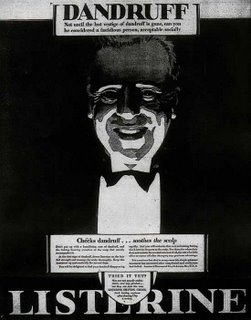 Mouthwash - it's not just for breakfast anymore... You have to admire the scare tactic taken by this particular ad: "Not until the last vestige of dandruff is gone, can you be considered a fastidious person, acceptable socially." Apparently, the threat of "non-fastidiousness" was sufficient to drive even the most callous dandruff sufferer to try virtually ANY product to rid them themselves of those unsightly flakes. One has to wonder if this advertising approach was dropped once the marketers of Listerine realized they could boost sales just as well by scaring people with the threat of bad breath.
Mouthwash - it's not just for breakfast anymore... You have to admire the scare tactic taken by this particular ad: "Not until the last vestige of dandruff is gone, can you be considered a fastidious person, acceptable socially." Apparently, the threat of "non-fastidiousness" was sufficient to drive even the most callous dandruff sufferer to try virtually ANY product to rid them themselves of those unsightly flakes. One has to wonder if this advertising approach was dropped once the marketers of Listerine realized they could boost sales just as well by scaring people with the threat of bad breath.
Sunday, April 02, 2006
Saturday, April 01, 2006
New Dove Shampoo
If you haven't tried it yet, give the new Dove Colour Care Shampoo a try. That is, if you have access to this product from the UK. (Hint: Color = US product, Colour = UK) I guess the extra "U" stands for for United Kingdom. In addition to it's pale pink, vaguely phallic bottle, the product is noteworthy because of its uncommon lotion like lather. Really. It's like rubbing a lubricious foaming lotion into your scalp. I've never used a shampoo that feels quite like this. It claims to be "reviving" for "lightened or highlighted hair." I don't know exactly what that means, but it did leave my hair feeling fairly conditioned. Any thoughts from the rest of the Beauty Brains?






